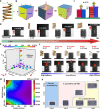Bionic Perception of Surface Adhesion via a Magnetized Spring-like Sensor with Axial Stretchability
- PMID: 40544493
- PMCID: PMC12224310
- DOI: 10.1021/acsnano.5c07356
Bionic Perception of Surface Adhesion via a Magnetized Spring-like Sensor with Axial Stretchability
Abstract
Perception of surface adhesion is one essential capability of a human fingertip, which is normally realized by touching the target surface with subsequent skin vibrations. However, such functionality is difficult to realize in flexible sensors and robotic systems due to the challenges in axial stretchability with reliable electrical feedback. In this study, we developed a bionic three-dimensional flexible magnetized spring (3D-FMS) that can quantitatively recognize surface adhesion based on electromagnetic induction. Combined with the laser processing with predefined patterns, we show that a raw flexible cube can be converted to highly stretchable spring-like geometry with excellent bidirectional deformation in axial orientation. Furthermore, the mechanical elongation caused by adhesion is critical for the induced voltage signals, allowing us to establish a model that relates adhesion strength with electrical outputs in a linear behavior. Via optimization of the process parameters, the device exhibits tailored stiffness to modulate the sensing sensitivity and working range on demand. With the established interactive interface, the wearable tests and robotic integration demonstrate the potential of the 3D-FMS for adhesion perception as a human fingertip. We expect that the strategy will offer a valuable reference to explore 3D wearable devices that advances robotic systems with more bionic functions such as stickiness determination.
Keywords: 3D magnetized spring; adhesion recognition; flexible tactile sensor; laser processing; stickiness.
Figures





Similar articles
-
Signs and symptoms to determine if a patient presenting in primary care or hospital outpatient settings has COVID-19.Cochrane Database Syst Rev. 2022 May 20;5(5):CD013665. doi: 10.1002/14651858.CD013665.pub3. Cochrane Database Syst Rev. 2022. PMID: 35593186 Free PMC article.
-
Active body surface warming systems for preventing complications caused by inadvertent perioperative hypothermia in adults.Cochrane Database Syst Rev. 2016 Apr 21;4(4):CD009016. doi: 10.1002/14651858.CD009016.pub2. Cochrane Database Syst Rev. 2016. PMID: 27098439 Free PMC article.
-
Atypical antipsychotics for disruptive behaviour disorders in children and youths.Cochrane Database Syst Rev. 2017 Aug 9;8(8):CD008559. doi: 10.1002/14651858.CD008559.pub3. Cochrane Database Syst Rev. 2017. PMID: 28791693 Free PMC article.
-
Home treatment for mental health problems: a systematic review.Health Technol Assess. 2001;5(15):1-139. doi: 10.3310/hta5150. Health Technol Assess. 2001. PMID: 11532236
-
Reading aids for adults with low vision.Cochrane Database Syst Rev. 2018 Apr 17;4(4):CD003303. doi: 10.1002/14651858.CD003303.pub4. Cochrane Database Syst Rev. 2018. PMID: 29664159 Free PMC article.
References
-
- Zhang Z. R., Wang X., Liu J., Dai C. S., Sun Y.. Robotic Micromanipulation: Fundamentals and Applications. Annu. Rev. Control Robot. 2019;2:181–203. doi: 10.1146/annurev-control-053018-023755. - DOI
-
- Flores-Abad A., Ma O., Pham K., Ulrich S.. A Review of Space Robotics Technologies for On-Orbit Servicing. Prog. Aerosp. Sci. 2014;68:1–26. doi: 10.1016/j.paerosci.2014.03.002. - DOI
-
- Lane D. M., Davies J. B. C., Casalino G., Bartolini G., Cannata G., Veruggio G., Canals M., Smith C., O’Brien D., Pickett M.. et al. AMADEUS: Advanced Manipulation for Deep Underwater Sampling. IEEE Robot. Autom. Mag. 1997;4(4):34–45. doi: 10.1109/100.637804. - DOI
LinkOut - more resources
Full Text Sources
Miscellaneous

